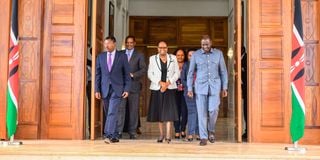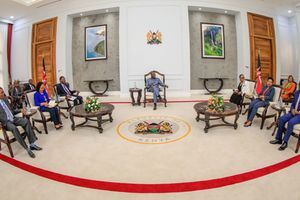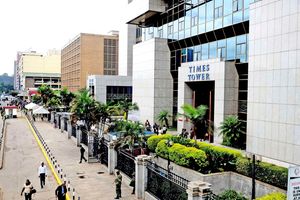
President William Ruto and Chief Justice Martha Koome after a dilalogue meeting that brought together the leadership of the Judiciary, Legislature and Executive at State House Nairobi.
The stages of the annual budget making process are set out at section 35 of the Public Finance Management Act. Budget making shall start with the integrated development planning process which shall include both long term and medium-term planning.
The current long-term plan is Vision 2023. As far as the medium term goes, the KK regime has their ‘Plan’. Governors have been launching their county integrated development plans (CIDPs) over the last 12 months.
This is followed by planning and determining financial and economic policies and priorities over the medium term. Treasury mandarins refer to this as the medium-term expenditure framework – MTEF.
At the start of a new administration, there is usually some hilarious, as well as hairy moments. Mandarins will be insisting that proposed expenditures must be within the MTEF, as approved by parliament and agreed with development partners. A new regime will on the other hand be trying to re-cast the MTEF they have found, in order to reflect their own priorities.
Still to avoid chaos, some continuity is necessary. For instance, you should not stop on-going road projects in order to start new ones. You cannot expect to sack the civil service you find, in order to hire a new one and so on. In practice, however, some of these misguided actions are going on.
A new regime can expect to re-prioritize at most one third of the budget. The current regime has been using this need for continuity to make the claim that they found empty coffers.
The medium-term plans are then formulated into overall estimates of revenues and expenditures. This is done in the form of the Budget Policy Statement (BPS), which is tabled for adoption by Parliament, usually by the end of February each year.
It is through these formulations that a regime’s ideas, and policies are translated into funded, actionable programs. The County Fiscal Strategy Paper (CFSP) is the equivalent at county level.
The three arms of state - the national government, the Judiciary and Parliament prepare budget estimates separately, and submit them to the National Assembly for approval (PFM act, section 37). Thereafter, the National Assembly enacts the Appropriation Bill and any other Bills required to implement the budgetary proposals. These include the debt management strategy.
The finance bill is the best known. It lays out additional taxation measures. It is incremental. It builds on what is already in existence.
This year’s Budget Policy Statement (BPS) proposes 4.2 trillion shillings in expenditures, excluding debt service, for the 2024/25 fiscal year. To finance these expenditures, it proposes Sh3 trillion in taxes – a growth of nearly 400 billion, from the current fiscal year. Sh487 billion will come from you paying for services directly, though e-citizen. Referred to as ministerial appropriations-in-aid, it is a form of tax. After all, the purposes of taxes is to pay for services! The balance will be borrowed, locally and abroad.
On income taxes, the regime calls for the re-introduction of minimum tax, as well as withholding tax on payments for goods supplied to the government, similar to services, to be collected as an advance tax. The regime proposes the introduction of VAT on education, and insurance services.
On excise duty, the regime proposes a review excise tax regime for alcoholic beverages to base taxation on alcoholic content. On Customs duty, it wants Kenya to request other EAC Partner States to review the structure of the EAC CET with a view of having one duty rate for all imported goods.
The regime has also set its sights on the hard to tax sectors. They propose the taxation of the agriculture sector, by introducing withholding tax on payments for produce delivered to cooperatives or other organised groups. They will further explore means on suitable taxation of informal sector, and introduce motor vehicle circulation tax payable annually by motor vehicle owners.
Much to the chagrin of the Controller of Budget, and contractors, both levels of government fudge the numbers while framing of the financing side. They overstate the expected tax revenue. This allows the national executive to show a lower budget deficit, and for both levels to ‘support’ a higher level of spending. This unstated deficit is the primary reason why we currently have nearly Sh800 billion in pending bills!
Unknown to most, procurement is not based on cash in the bank. Rather, it is based on the approved budgets. These in turn are to be financed by expected taxes and borrowing. But revenue shortfalls are the norm. And sometimes market conditions, such as high interest rates, or internally inflicted problems such as a poor credit rating, make it difficult for the national government to borrow.
To illustrate with actual numbers, this regime first indicated national tax revenue of Sh2.7 trillion for the 2023/24 fiscal year. This allowed them to claim a reduction in the budget deficit. The revenue estimates were later adjusted to 2.5 trillion during supplementary budget I, with the consequence that the actual deficit is now estimated at 934 billion shillings. Since expenditures were not reduced, pending bills will grow with an amount equal to the revenue short fall.
The revenue estimates in the MTEF are themselves fudged. The much talked about fiscal consolidation and deficit reduction are a mirage. In the year September 2023, the stock of public debt grew by Sh1.82 trillion shillings or 20 per cent.
Debt service is estimated at Sh1.87 trillion shillings in the current financial year. The larger portion (Sh1.03 trillion shillings or 55 per cent) will service domestic debt. External debt service, currently at Sh839.14 billion shillings (or 45%), will continue to escalate as the shilling depreciates.
As projected in the budget policy statement, the medium-term expenditure framework maintains these trends. It can only get worse.
@NdirituMuriithi is an economist







